- A1 Engineering
- Posts
- End Meeting Madness And Reclaim Productivity
End Meeting Madness And Reclaim Productivity
Escape the meeting treadmill and regain control of your time
Meetings. A word that symbolizes you have entered the corporate world. Whether you are at a Fortune 500 company or at a Series A startup, you can’t get away from meetings.
There are people who say that meetings are important. Establishing collaboration and clarifying interfaces is crucial for the success of the business? Maybe. But to the extent we have accepted as the norm today? Unlikely.
Maker vs Manager
Each time any discussion about meetings comes up, it is hard not to think about Paul Graham’s essay about the Maker vs Manager schedule. On the left is what we have come to accept as the Manager's schedule. On the right is what the ideal Maker schedule looks like. I am always striving to veer towards the maker's schedule while ensuring I am not forsaking on my duties as a manager. This pursuit isn't always successful.
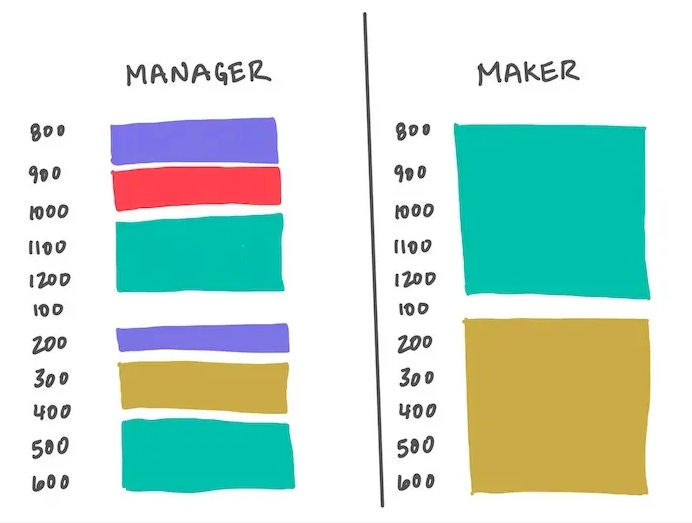
The manager's schedule is for bosses. It's embodied in the traditional appointment book, with each day cut into one hour intervals. There's always something coming on the next hour; the only question is what.
When you're operating on the maker's schedule, meetings are a disaster. A single meeting can blow a whole afternoon, by breaking it into two pieces each too small to do anything hard in. Plus you have to remember to go to the meeting.
15 years on, this essay still rings true. Any person in the workforce (maker or manager) has meetings that roughly fall in these categories -
Regular checkins - typically called “1 on 1s” and occur on a weekly/biweekly/monthly cadence. These could be with your team, your stakeholders, your manager and so on.
Scheduled small group meetings - collaborative sessions that occur on a weekly/biweekly/monthly cadence like backlog refinement and sprint retrospectives.
Informational large group meetings - company wide sessions that are used to disperse information across the employees, and occur on a monthly/quarterly/annual basis.
Adhoc meetings - pretty unpredictable and based on what the situation calls for. They could be groups of people or even a couple of people trying to pair program or use this time for sounding out ideas.
Besides these you might have some function-specific meetings -
For example if you are customer facing, you might have a slew of engagements to meet your constituents either in person or virtually.
If you are vendor facing, you might need to connect with your customer success representatives for things like contract renewals, cost discussions.
If you are a C-Suite member, you might have things like board meetings, roadshows, fundraising, customer sales, strategy sessions.
If you have gotten this far, you recognize this list. Heck, you might even be going - “Arjun - you haven’t even covered this entire other list of meetings that I am required to attend/run”. Yes - that is true. We have trapped ourselves in a labyrinth of meetings to execute initiatives.
As you grow, so shall you meet
The higher you go up in your career, the bigger your sphere of influence gets and at some point, your team is not just your team. Your stakeholder peers are also your team. This means that ensuring their success is also part of your responsibility.
Let us take a contrived example to follow this progression for a manager. The character in orange is our protagonist (let us say this is you) and the characters in green are the people our protagonist has regular checkins with.
Upon being hired
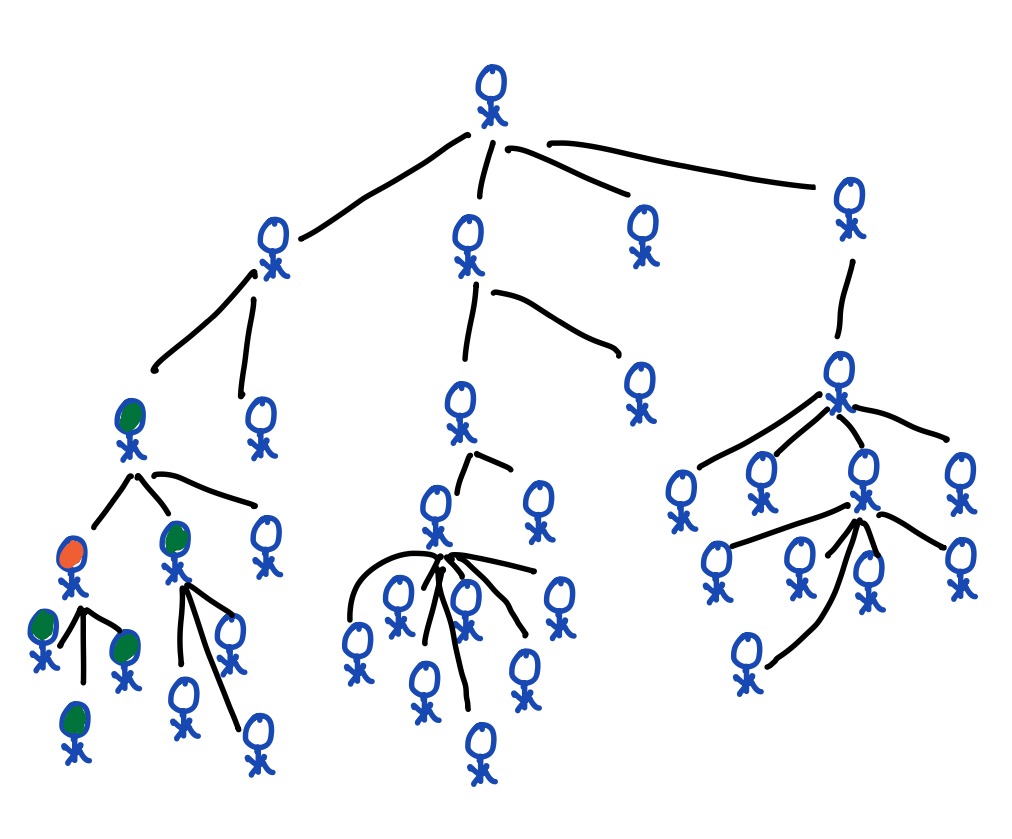
When you are a junior engineering manager, you are expected to mostly have your checkins with your direct reports and manager and maybe a peer or 2.
🤝 “Checkins” counter: 5
After 1 Promotion
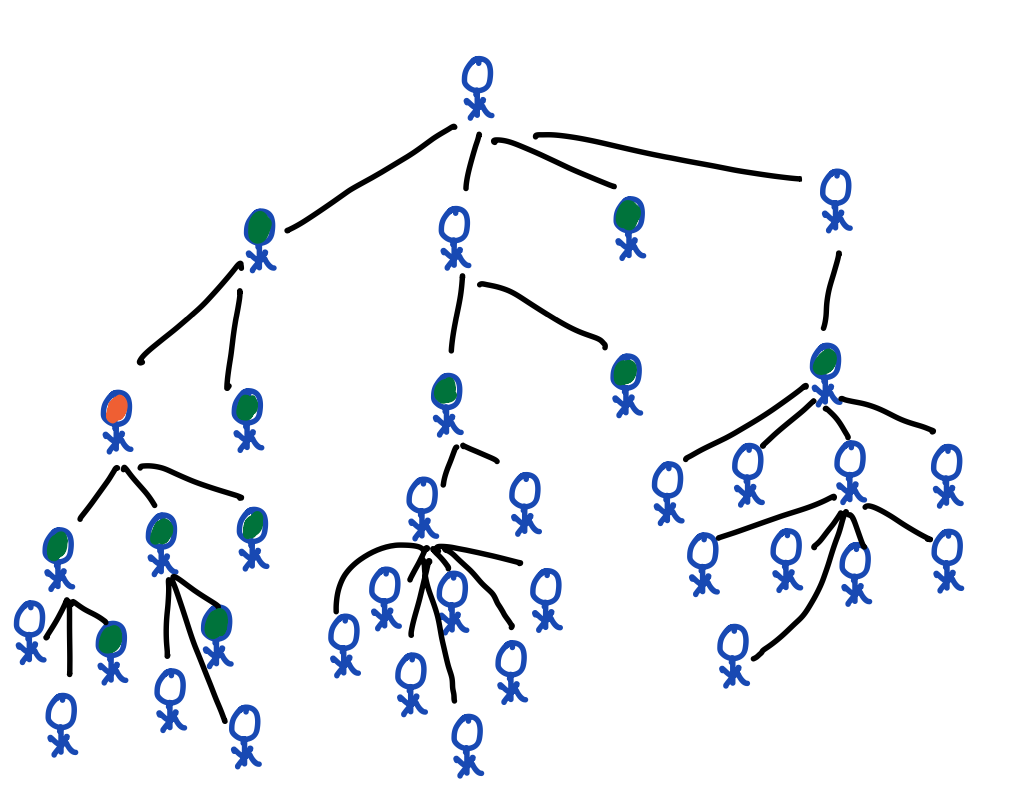
When you get promoted, you are now in charge of a group of people. As before, you are expected to have one-on-ones with your direct reports and your manager. In your new position, you are also expected to have checkins with your peers and maybe a senior member to make sure all things are working as expected. You might also do skip-level 1 on 1s to keep a pulse on the team.
🤝 “Checkins” counter: 11
After 2 Promotions
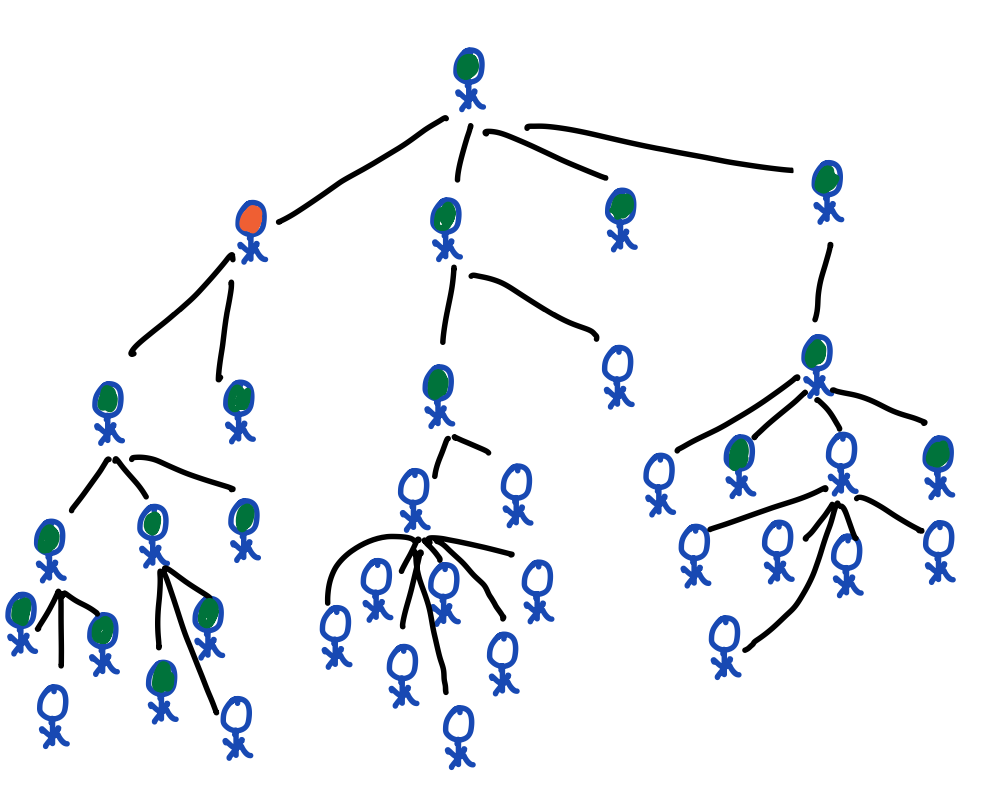
When you get promoted again, you are now in charge of a department. As before, you are expected to have one-on-ones with your direct reports and your manager. In your new position, you are also expected to have checkins with all your peers and maybe some of their reports to make sure all things are working as expected. You will also do several skip-level 1 on 1s to keep a pulse on the team.
🤝 “Checkins” counter: 17
As you can see, the number of meetings has increased drastically, and these are just the 1 on 1 checkins. This also assumes that the organizational size remains the same while you are getting promoted, which in most cases is unlikely. This means that these numbers are likely on the lower end.
The impact of meetings on culture
Meetings can be a useful tool but when either of the scenarios highlighted below occurs, that can lead to a bad culture.
Someone feels like they are not useful if they are NOT in meetings
People say things like “I wish I had fewer meetings so that I could get to the work I really need to get done!”
The first scenario leads to creating a self-fulfilling cycle - the more a person doesn’t feel worthy if they aren’t in meetings, the more meetings they will try to get into or create, which will create knock-on effects for other people in the company.
The second scenario leads to burnout and disenchantment. It is a call to action for the managers/peers to ensure that the sentiment is well understood. I fully believe that this scenario is possible but at the same time I find it to be ridiculous we have gotten ourselves in a place where it actually happens.
Being a pure-play people manager is not a lasting trend. Yes, there will always be places that have 1000s or 10s of 1000s of employees who will need purely people managers. Maybe there is still a place in those companies for that kind of individual. However, for the vast majority of people who are either ICs or people managers in small-mid sized companies, there is an expectation that a large percentage of their productivity is driven by their individual contribution.
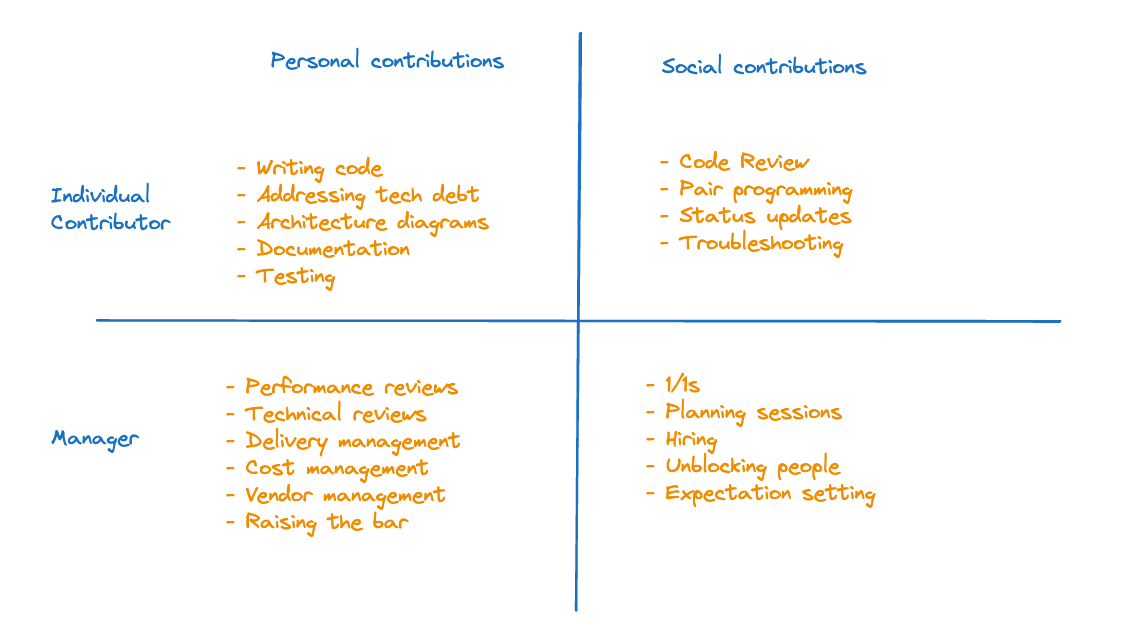
What a high meeting environment optimizes for is social contributions, which will not encompass the personal contributions an individual is responsible for. This doesn’t just mean that the person won’t get their job done on time. It means that the person will start questioning if they are growing in the most optimal way possible. This leads to disgruntled employees who seek greener pastures. While there are several reasons for people to look for new opportunities, this can often be the final nail in the coffin.
So what can we do about it?
As a group we must understand that this scenario we have put ourselves in is ridiculous. It is stasis that we have all acknowledged is necessary for the greater good.
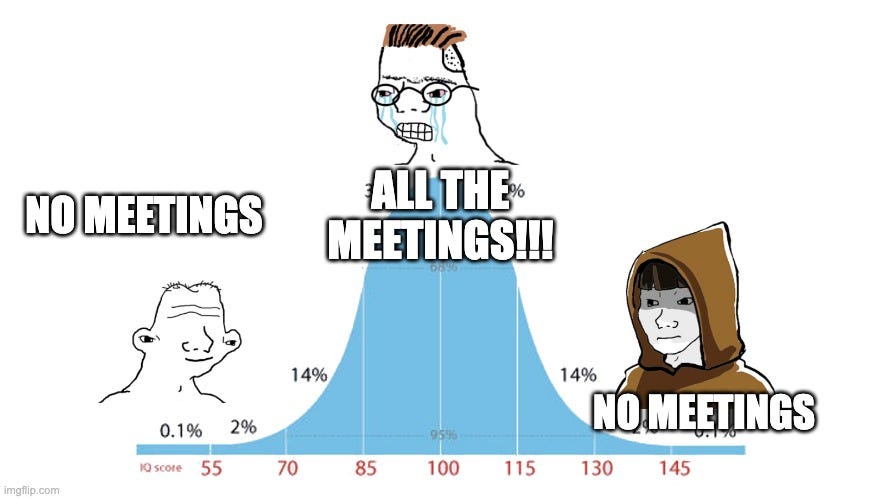
How do we break out of this cycle? We can take heed of these 6 actions -
Focus on speed. Speed is king - Focus on the “Now” not “How” (shoutout to Noah Kagan). So much of meeting continuum is invested in the future planning of “things”. Whereas if you just do it you will likely find out significantly more things, than if you had planned and talked about it.
Fewer meetings for all - Get upper management buy-in into consciously reducing the amount of meeting time people are subjected to. This is not always easy since there are internal or external commitments you can’t avoid. But if you can’t get to this point, then this is likely a lost cause for you. As a hammer, you could institute something like “No meetings wednesday” which would need to be a shared commitment.
Spare the makers - The makers are the people you need to value in your company because they are the ones producing stuff. If you are disrupting any time on their calendar, you are effectively saying what they are doing is less important that what you are asking them for. In few cases this might be the case, but don’t make that the default assumption. Be cognizant of the impact of your actions.
Async over sync and keep communications concise - Fewer synchronous sessions prevents the mental bloodbath of meetings. However, it is easy to polemically vote for async communication but also mess this up. The way it usually happens is that someone unleashes a firehose of comments on confluence/github/google docs/coda. This now requires an intense back and forth, either on the document or potentially synchronously if the gaps are too far apart. Instead, keep your comments concise and to-the-point. Aim for density, not volume with your comments.
Be ruthless for the sake of others - Slash meetings that are not productive.
If you are running the sessions, be brutally honest with yourself to see if there is any value in the session.
If you notice high participant meetings, raise the exact same question with the organizers of those meetings. Ask them to either
Cut the meeting
shorten it and make it significantly more productive or
reduce the participant count if their attendance is not required. Meeting attendee creep is a reality and when you see something, say something.
Be ruthless for your sake - You have done everything you could to reduce meeting time for other people. Now time to help yourself.
Use apps like reclaim.ai to create focus time blocks for yourself that proactively rejects new meetings from colliding with your focus time.
If you think you are on far too many meetings, take yourself off them. See what happens. Do things crash and burn? Do you hear about people noticing your absence? If so, is it because something got stuck or not get done? If that is not the case, then you weren’t required in the meeting.
Often people use meetings to learn about things happening in other parts of the organization. If you are losing out on this context, find alternate ways like reading meeting minutes or written documentation to be plugged in or leverage your other 1/1s to get this information.
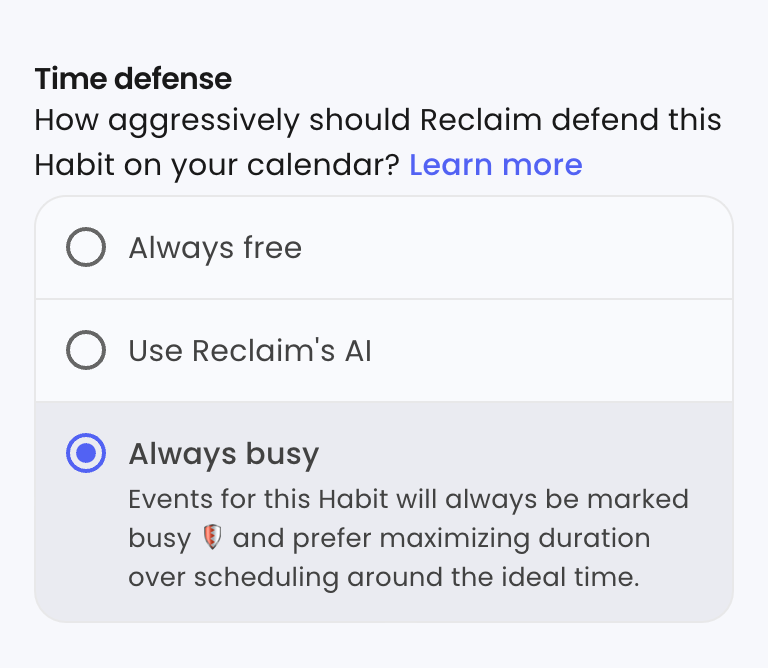
Source: Reclaim AI
💪 Keep Calm and Carry On
Unfortunately, this is a hard problem and we have been talking about it for decades now. It is hard because it requires collective buy-in from others. If others don’t see the benefit of this or institute alternate practices to make fewer meetings happen, it is a losing battle. The way organizations are setup to communicate with each other also impedes this from being a problem that has an easy solution.
However, if you are able to convince others of the benefits of this approach, and incrementally are able to reclaim time, you will find that you might just be able to move that needle everyone is talking about.

⭐ If you liked this, be sure to ♥️ this post and follow/subscribe at https://a1engineering.substack.com/subscribe! ⭐
Reply